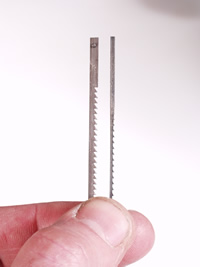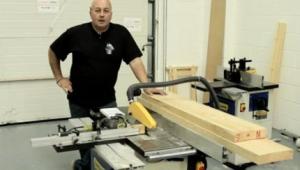An introduction to Scroll Saws

If you intend to tackle any really intricate cutting jobs, then the machine you need is a powered scroll saw. These rather delicate looking machines are capable of producing the finest work, and are one of the safest cutting machines available. They tend to be more associated with craft work and modelmaking, than furniture projects, however they are surprisingly robust machines and can cope with timber up to about 50mm thick. They can also cut intricate shapes and curves that are impossible on any other powered machine. It is, in fact, a scroll saw rather than a jigsaw that is used to produce jigsaw puzzles.
There's something rather relaxing about scroll sawing...
A well set up tool should run smoothly and cut cleanly with little vibration or noise. Almost any radius of curve can be achieved with care, and complex shapes are easily produced. Another important feature is that because the blades are thin and easily fitted, it is possible to cut internal shapes by drilling a pilot hole and then threading the blade through it and re-connecting it to the machine. This is known as pierced work, and if you intend to do a lot of it, it’s worth acquiring a saw with a quick blade-release system. Blades come in two different formats, those with plain ends and those with pin ends. The pinned blades have a tiny rod through each end which locates in the blade holder and minimises the chances of the blade slipping out. The plain blades rely on clamping pressure alone to hold them in place.
Safety
Scroll saws are one of the safest machines and are popular in school workshops. Obviously any machine that can cut wood can cut your finger, however, if you observe basic safety procedures, accidents are very rare. Keep your fingers away from the cutting line and make sure that you are using the correct blade for the job. The blades are very fine and break easily, if forced, though this poses little risk to the operator, and the blade is easily replaced.
Making the most of your blades
If you usually cut only thin material, you will only wear the bottom part of the blade, which will eventually become blunt. Rather than discard it while the upper part is still sharp, make a secondary table out of 18mm MDF which can be put on top of the machine’s own table. This will allow you to raise your work up and use the sharp teeth higher up on the blade.
Using a scroll saw
Before use the machine must be firmly bolted to a bench or stand, so that it is secure and vibration free. Position a strong light near the table so that you can see any fine detail clearly. Start the machine and gently feed the blade into the workpiece along your marked line. Hold the workpiece down on the table and move it steadily to obtain a good finish. When negotiating particularly tight corners you may need to pull the workpiece gently towards you to stop the blade cutting as you turn the work. Be careful not to exert any sideways pressure on the blade. If you need to reverse out of a cut, it is better to switch the machine off first and then carefully withdraw the blade. The secret of successful scroll sawing is to use a light touch and be patient.
Table
The table on a scroll saw needs to be particularly smooth to produce as little friction as possible so that your workpieces will slide around easily. It should also be easy to tilt, so that you can make angled cuts, and must lock firmly in position. There are no fences on scroll saw tables, and all work is done freehand.
Motor Power
Scroll saws need little power to operate efficiently and their motors are rated at around 100 watts. They all use induction motors, and run extremely quietly.
Hold downs
These are used, as the name suggests, to hold the work down onto the table. They are only really needed when working very thin stock, which can get lifted by the blade on the upstroke. They also serve a secondary function as blade guards, making it difficult to get your fingers too close to the blade.
Guarding
In addition to the hold down, some machines incorporate a Perspex guard that hinges down over the blade. Any fitting that makes a tool safer for the user is normally to be applauded, however these guards are both cumbersome and unnecessary on such a docile machine, and personally I would prefer not to have them.
Blades
There are two different types of scroll saw blade; plain ended and pin ended. The pin ended have a locating pin in each end, similar to a junior hacksaw blade, that makes it very easy to fit and tension them in the machine. The plain ended blades must be held in clamps, and can be a little more fiddly to install. The main difference is that the plain ended blades can be considerably narrower then the pin ended blades as they do not need to have the width to accommodate the pin, obviously. All the machines here can accept either type of blade.

Pin end and plain end blades side by side

A selection of different blades
Scroll saw blades, like jigsaw blades, are available in a range of sizes and patterns to suit different jobs and materials. They are graded from 1 to 12 with the lower numbers having the finer tooth pattern suitable for thin materials and more intricate cutting and the larger number becoming coarser and thicker making them more suitable for heavier work. When installing a blade, always make sure that the teeth are pointing down towards the table.
Cutting speed
When tackling particularly intricate jobs, or when cutting difficult materials, the ability to vary the cutting speed is a great help. All the machines except the Record have variable speed. The Record has a two position selector switch offering high or low speeds.
Conclusion
You can achieve a good result using any one of these machines as all of them are perfectly capable. Unsurprisingly the Hegner is by far the most pleasant machine to use, with its quiet motor and sensitive variable speed, it is the one to beat; though the blades can be a little fiddly to fit. The Delta is also an impressive and weighty machine with its cast iron table and reasonable price. It has a particularly good blade clamping system and effective dust extraction. The Ryobi just edges ahead of the Record, by virtue of its variable speed motor and superior finish.
Dust extraction
Due to their tiny blades, scroll saws do not generate a great deal of mess, but one of the main problems is keeping the cutting line clear of dust. All the machines here are fitted with tiny bellows that blow air onto the cutting line via an adjustable tube, which generally solves the problem. They also have extractor connections under the tables to allow a workshop vacuum to be used. The Delta is particularly efficient here with a fully enclosed base. In this test we are featuring four machines from Hegner, Ryobi, Delta and Record with prices from less than £100 to over £400.
- Log in or register to post comments














